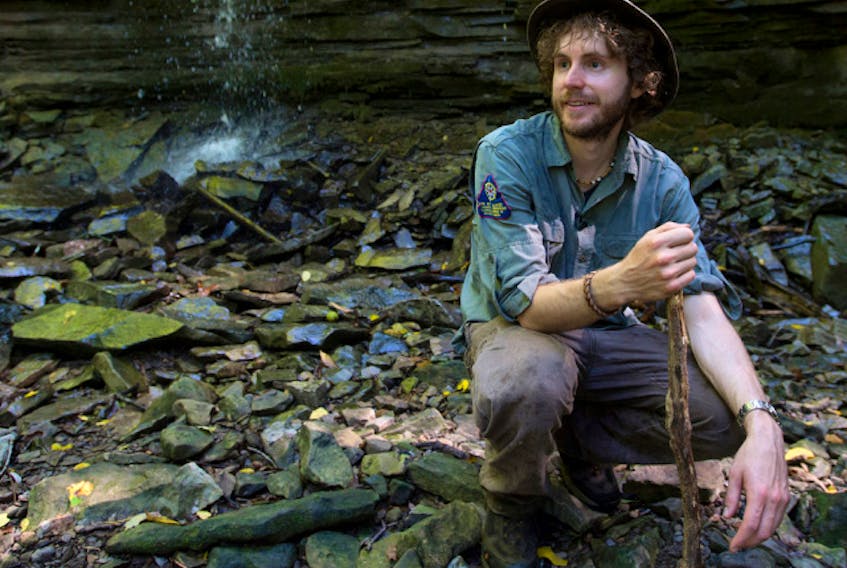Adam Shoalts is in the forest, as usual. In fact he is in the woods near his home in Norfolk County, Ontario, which is the most highly forested area in the southwestern part of the province, with more than a quarter of the land covered in trees. Shoalts is at his most comfortable out there among them. When I reach him on the phone one recent weekday morning, I find him out marvelling at the breadth of Carolinian diversity: the Shagbark Hickory and the Manitoba Maple, the Cucumber Magnolia and the Eastern White Cedar. This is a man who understands solitude, who likes nothing more than to be alone among nature. “I was social distancing before it was mainstream,” he explains to me whimsically.
A historian, archaeologist and geographer, Shoalts is at heart an explorer, in the best venturesome frontier tradition. He holds the prestigious position of “Explorer-in-Residence” with the Royal Canadian Geographical Society, which essentially means he is free to mount expeditions under the society’s esteemed aegis whenever he chooses, and he was once described in a profile in the Toronto Star as “Canada’s Indiana Jones,” a moniker that has followed him since.
When I met Shoalts last December, at a holiday party and fundraising event for the Geographical Society, he was nearing the end of a long promotional campaign for his latest book, Beyond the Trees, which had been released earlier last year and was a national bestseller. He briefly explained to me the subject of the book: the four-month, 4,000-kilometre journey he made, entirely alone, between Eagle Plains in the Yukon to Baker Lake, Nunavut, on foot and by canoe, often against the current. “That must have been very difficult,” I said. “No, that was easy. This — ” he said, gesturing around the room, at the garrulous partygoers having a good time, “— is way harder.”
Most of us, choosing between the social function and the unforgiving terrain of the Canadian arctic, would favour the party. But six months later, in the middle of a global pandemic, we are all still living mostly like Adam Shoalts — closed off from ordinary human contact, sequestered in isolation, and though we may not have to endure the elements at the end of the Earth in the manner detailed in Beyond the Trees, we have to get used to unconditional, seemingly never-ending solitude. Who better to guide us through the loneliness than a self-confessed hermit with a proven knack for keeping to himself?
You just can’t overthink this stuff
“You’re going to think I have no insight into this at all,” Shoalts laughs, when I pose the question of how to deal with isolation. “But I never really reflect on it. I take each day as it comes. I don’t get too much in my head or think too deeply. I do what needs to be done and take each task as it is. You just can’t overthink this stuff.” The clarity and immediacy of his attitude around life and hardship is enviable. He is like a pro athlete before a game, taking nothing for granted, taking everything as it comes. It’s easy, he says, to feel overwhelmed by challenges — to be daunted by change. The key is to be flexible. “It’s the old expression, ‘If life hands you lemons,’” he explains. “If COVID shuts everything down, adjust accordingly and get on with things. You just do what you have to and not overthink it.”
Shoalts has been spending time alone in the wilderness since he was 10 or 11. As a teenager he would embark on longer excursions — a week or two in the woods with a tent and little else — with a close friend. It wasn’t until he was in his 20s that he attempted more ambitious solo efforts. At first, he explains, the solitude can seem disconcerting. “But you adjust to that pretty quickly. You begin to relax. And eventually you learn to enjoy that more than anything.”
He emphasizes the importance of staying busy. “If you are socially isolated, working on a task is the best tonic. The worst thing is idleness.”
In the remote regions of the north, mid-expedition, he found himself trapped on a peninsula, pinned in place by strong winds. Stuck, unable to move, he suddenly felt anxiety closing in on him: “Scenarios race through my head. It’s already mid-August; it’s only going to get worse. Winter is coming. I will be trapped here. Worry is eating away at me.” Instead of brooding, he devised a plan — he focused on what should come next. “As soon as I start thinking of plans I feel better,” he says. “It’s when you’re idle that you run into problems with anxiety and boredom. The worst thing you can do is just sit there and stew. You have to give yourself something to focus on.”
Of course, in quarantine we may not have such pressing concerns as the looming winter weather and dwindling supplies of food. But Shoalts is quick to enumerate the “endless amount” of things you can do at home. He’s the sort of person who wouldn’t dream of squandering his time on something as dreary as television. (“How does anyone binge-watch TV?” he asks, completely bewildered. “That’s so boring.”) Instead, he recommends more hands-on, practical pastimes. “Think of all the skills you can practice. Think of knots: get some string or rope and make yourself a master of knots. Or learn how to make a fire without matches. Or work on your bird calls.”
Shoalts acknowledges that the experience of lockdown looks different for different Canadians. There’s a major distinction between living in a condo in a major city centre and living “on a dead-end road where there are no sidewalks or streetlights and even on a busy day you don’t see anyone.” In terms of “the most practical sense of physical geography,” Shoalts feels, it’s bound to be more difficult to self-isolate when you’re trapped inside a small one-bedroom apartment without access to the trees and birds and wildlife someone such as Shoalts needs for his wellbeing and mental health. “Our brains are hot-wired to want that,” he says. “There’s a reason people are more relaxed around trees than around concrete and glass and asphalt.”
For Shoalts, solitude is pleasant only when there’s nature to explore. These enormous metropolitan areas without forests or nature conserves, without a readily accessible public space outdoors, are part of the problem. “If there’s one takeaway from the shutdown, it’s that our urban growth strategies for big cities like Toronto need to factor in more green space,” he argues. “We need to put the brakes on development and start looking at ways to get more green space in our cities. People need to be able to go outside. They need to be able to have quiet time in nature. They need parks. This should be an essential service.”
They need parks. This should be an essential service
One of the easiest and most helpful ways to deal with isolation is to spend some time outside in nature. It’s really that simple. But what this quarantine has made abundantly clear is how severely our cities lack access to places where simply being outside among trees or birds or wildlife is even possible. “If you have more and more people, and fewer and fewer of these places, it becomes impossible to achieve that,” he says.
Trinity-Bellwoods park in Toronto is 38 acres. Shoalts says it needs to be a thousand acres. “It’s a straightforward equation. You have a number of residents, and you need a certain amount of park space. You need more park space in the city.”
If we’re going to expect people in this country to protect themselves against the spread of infection and continue to self-isolate long-term, and if we’re going to expect that they emerge on the other side with their health intact and their quality of life undiminished, they need better access to generous expanses of open nature. It’s the only way that solitude really works. This is at core a city-planning issue, and not something, Shoalts admits, that can be fixed overnight. But where people are concerned, nature trumps all.
“Having said that, I’m talking to you right outside in nature, looking at trees and birds, and thinking it’s the greatest thing in the entire world,” he laughs. “Maybe it’s just me. But that’s the way that I look at it.”
Copyright Postmedia Network Inc., 2020









